Can you use your drill as a sander? The short answer is yes, you could use it with drill sander attachment. Of course, comparing to real sander it won’t work very well. If you work with a cordless drill, the battery will run down pretty quickly, and the torque is not very big. Using a corded power drill for a sanding is much better. But still it is harder to control, and sand paper wears out quickly.
Table of Contents
The same situation is with rotary file bits. With corded drills they work better than in cordless, but again, the there is a rotozip tool that is designed for that use, and it works spectacular.
Nevertheless, for the folks who are not making all their money in the shop or garage, drill sanding attachments are great. A lot of hobbyist, DIYers or just handymen have the sanding drill bits in their toolbox.
Disk drill sander attachments
I have used a repair kit which consisted of a drill sanding attachment with two spot pads and backing plate. The finish wasn’t really impressive but later I’ve used a variable speed drill and I could see it working quite effectively for areas that would be hard to reach with a sander. Cordless is handy when out on a car forecourt, but it’s definitely not for anything more than spot repairs.
The kit is good for headlights polishing. I should say, in my opinion, the vast majority of people uses drill to polishing headlamps. I also tried this and got decent results removing oxidization from auto parts. I find out that better to use the drill with faster speed but it wasn’t very easy to control for long periods. If you want more space between the headlight and the drill, you could buy a longer bit attachment piece.
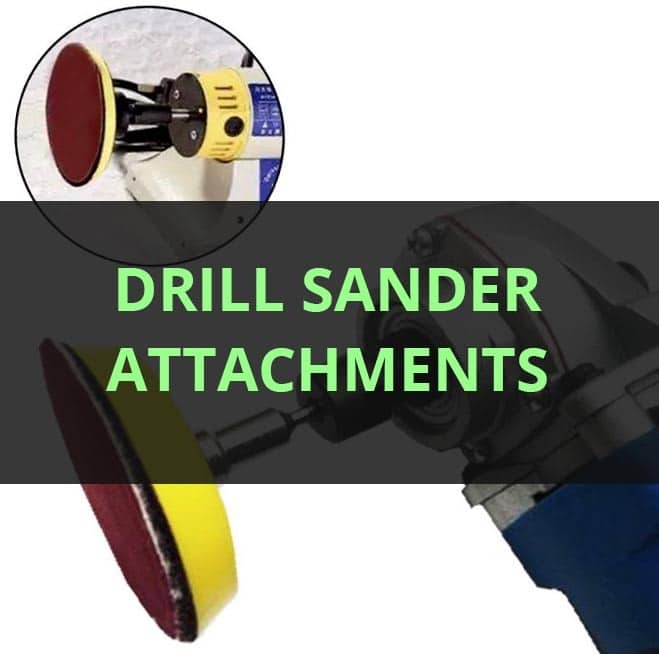
I have seen drills used effectively with buffing and polishing pads. Mobile paint less dent repair sets often use a drill with pad for polishing after wet sanding, just for a small area though. My friend used drill to polish exhaust tips. I haven’t done it personally, however, I think that they are very unstable.
If you have a hammer drill or simply big and powerful enough device to give you a side handle, then it may be more convenient but I imagine it would be pretty awkward. That’s similar to the wire wheel, you can control it but you have to fight it some.
My friend woodworker uses an old Black and Decker drill that runs at about 2500 rpm to polish wooden bowls. He works slow with lathe speed 4-500 rpm and uses 2″ Mandrell sanding the inside walls keeping the pad moving all the time. The attachments works with his own disks from cloth backed sheets with a sharpened plumbing union and a hand sledge on a piece of Brazilian flooring. The angled drill is too large for the task.
Drum-type drill sanding attachments
I’ve used drum sanders on an electric drill. And I should say, the trick is to keep moving. If you stop in one spot, the drum digs in a bit and then it just stays in that spot. It’s also easy to burn the sandpaper so I would advise a slower speed (1000 – 1500 rpm) and the more coarse the grit the quicker it will remove material. Often I turn a wood drum horizontally. That way I keep the work moving which prevented burnt sandpaper.

Unpleasant fact is that some sanding drums don’t stay on the bit. You tighten the little screw at the end, and when turn it on and start sanding, the sandpaper part flies away. I wedge a small bit of paper between the sanding drum and the wheel and that helps, some.
Do not use round sanding drum or disk on a drill, when sanding a plastic auto parts like bumpers. You will not have an acceptable surface after trying it.
Power drill sander attachment for drill press sanding
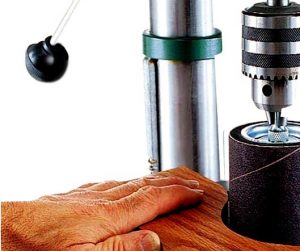
Though a drill press is not designed for radial loads, it can take it. And it can take it forever. I use drill press sanding attachment and drum for many years with no noticeable effect on my old machine. The key is to let the sandpaper do its job, and don’t apply lot of pressure. Just take your time and don’t be tempted to put your weight behind it.
I also purchased a set of various sized drums that use regular sandpaper held in a slot with a locking cam. Some drawback of drum-sanding on the drill press is that there is no oscillation and sanding marks on the surface must be dealt with.
You can even use a Dremel sanding discs, but for really simple tasks
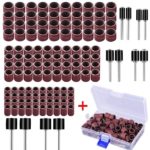
For the fine work you can attach Dremel sanding disc to your cordless drill (best Dremel bit for cutting wood). It won’t work so fast, because Dremels rotate much faster. Also take into account, that Dremel sanding drums, discs and stones are usually quite small and shaft diameter is tiny. They are designed to rotate at about 3 000 – 30 000 rpm, and most drills work with 1400-3000 rpm.
So, you should better buy sanding and grinding disks for a drill. They have a much larger circumference and it makes up the lack of rpm’s, using bigger torque of the machine.
If you plan to work often – buy a professional machine, they are not very expensive
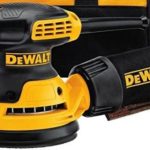
Drills are good for making holes. If you plan on sanding more than about a square foot area and do it more than once, you really need a tool built for the job. For example, if you want to sand your floor with a drill, you’ll definitely wish yourself dead about 1/100th of the way into the job. Invest in a real disk sander. Buy the hardback disks and you will make the job much quicker; the finish will be smoother. Sometimes you will spend less on a few disks and a sander than all the sanding disks for the same job with a drill.
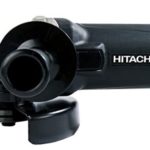
Sanding long edges of a wood, fiberglass, plywood, etc. is done better with an angle grinder. Once you get it, you’ll never go back. The little drill sanding discs are too small for any hard work, and the fiberglass dust act like sand in the electric motor and wear it out prematurely.
You can also cut very effectively and accurately with angle grinder, but again it’s important to maintain a very tight grip. Don’t be in a rush, measure twice, cut once.
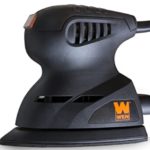
The trick of using angle grinder with a sanding disc is to be careful with your movement and pressure as it can take away far too much material. If you grip it very firmly and watch what it is taking off, it’s doable even on large panels with care. You may perform finish sanding with your drill though. You’ll definitely find more uses for the machine. Like sharpening stuff, cutting hard plastic, metal shaping, cutting off padlocks when you lost the key.
If you want to use an electric tool, I would also advise you to get a palm sander. I use them once in a while if I have a lot of sanding to do and don’t want to run the compressor all day.
Safety first
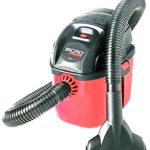
Any sanding yields fine dust that is unpleasant or noxious. Using a power tool creates more dust that travels farther. Wood, fiberglass, or other dust are harmful for your lungs, so if you have a vac with a filter bag or cyclone, set it up near your grinding table. Get special dust masks in paint dept. for drywall/fiberglass. Wear gloves and rinse arms in cold water after finishing the work.
Conclusions
Therefore, the cons of sander attachments are:
- Sanding is pretty hard for cordless drills, they discharge quickly;
- If you use a drill, it acts more like a grinder because it tends to go in circles;
- Both corded and cordless are harder to control, than real sander.
The pros are:
- If sanding is a rare task, you save money and space in your tool chest;
- Hard to reach areas are sometimes easier to work with the attachment;
- You can hurt yourself with a real sander, using drill is a little safer.